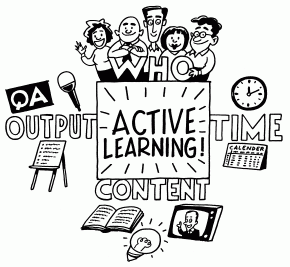
Why are some customer service training programs so dull, and others so full of active participation? What makes one trainer plod along, while another is well-known for bringing energy and effectiveness to each session?
Over the years I have developed a technique for customer service training that generates active participation every time, even with the most reserved students and in the most conservative cultures. I use it for customer service training workshops, team building programs, course curriculum and conferences. I use it once or twice for quick icebreakers, and over and over again for longer-term educational programs.
I call it “Ron Kaufman’s Active Learning Toolbox.” The box has four key components, each of which is essential to your success. Here’s how the components work together.
1. Who am I doing this with?
People must be very clear about who they are working with. Is this an exercise to be done alone? Am I supposed to work with a partner? Is this a task for everyone in the room to work on together? Should we tackle this with the folks seated around our table?
Who should I be working with right now? This is essential for focusing customer service training or other educational programs.
2. How much time do we have?
Is this a task to be done in the next ten minutes or should we prepare our answers overnight? Is there a need for speed (“Complete this as quickly as possible.”) or is the time clearly fixed (“You will have until 11:00 a.m. to finish.”)?
How much time do we have to get this done? A clear time reference is essential to motivate during customer service training.
3. What content are we focusing on?
Are we sharing our opinions on a topic? Or comparing our experiences in the field? Are we working on a case-study, discussing a video, debating a presentation or refuting an article we’ve been asked to read?
What content do you want us to focus on during the time we have to work together? This is vital for helping participants in customer service training zero in on what’s important.
4. What output are we supposed to create?
Do you want us to come up with one answer for the group? Or a list of five possibilities to discuss? Do you want us to prioritize problems to be resolved? Or generate a series of action steps with dates, responsibilities and outcomes?
What output do you expect us to create or complete in the time we have to work on this content together?
When all four elements (who, time, content and output) are clearly understood, people will participate in customer service training. If any of these areas are unclear or uncertain, many will hesitate.
Here are some examples of putting “Ron Kaufman’s Active Learning Toolbox” to work in customer service training. Notice how each example clearly explains who, time, content and output.
New group introductions during customer service training:
Sit in groups of four with people you do not know well during customer service training. Take two minutes each to describe the nature of your work, who you serve and who serves you. Listen carefully to what others in your group say about themselves. After each person has spoken, take the next four minutes to discuss what you have in common at work and what is different.
Who: groups of four. Time: twelve minutes total. It may help to ring a bell at appropriate intervals to keep the groups on time. Content: participants’ actual work and their daily service contacts.
Output: relevant sharing of information and resulting familiarization among those in the group.
Learning with an in-class or on-line video:
Select one person to be your partner. Watch this ten-minute video together. Discuss for four minutes what you and your partner consider to be the top learning points in the video, and which you agree is the most important for your work. The partner with longer hair (or darker shoes) will present your choice of “most important point” to the whole group during customer service training.
Who: you and a partner. Time: fourteen minutes total for video and discussion. Content: a pre-selected video. Output: one partner prepared to present a key learning point.
In the next set of examples, notice how the output of each exercise becomes content for the exercise that follows in customer service training. Using this simple technique, your meeting or workshop will enjoy a natural flow of participation and cascading value.
Find the Service Problems:
Sit with your department and choose a scribe to write at the flipchart. In five minutes, brainstorm all current service problems in your department. The department with the longest list during customer service training “wins.”
Who: all department members, one scribe. Time: five minutes. Content: current service problems.
Output: longest possible list.
Focus on the issues during customer service training:
As a department, review the prior list for ten minutes. Consolidate the service problems into four or five key issues. Make a new list with only those key issues on the chart.
Who: all department members, one scribe. Time: ten minutes. Content: previously generated list of service problems. Output: consolidated service issues.
Prioritize for improvement during customer service training:
Each person gets five stickers, numbered 1 to 5. Everyone votes to prioritize issues from the prior list by placing their stickers on the flipchart: 5 = top priority, 1 = lowest. Tally the votes. Then rewrite the list so the issue with highest number of votes is on top, lowest on the bottom.
Who: all group members. Time: immediately. Content: the previous list of consolidated service issues. Output: group prioritization of the issues.
Can you imagine the next applications of “Ron’s toolbox?”
Divide into groups based on the top three issues. Each customer service training group brainstorms a list of solutions then prioritizes the list. One group member presents the prioritized solutions. Others in the department raise two appropriate questions. This process delivers layer after layer of value and is bound only by your need for results – and your imagination.
This active learning technique works best when people understand “what’s in it for them.” Here’s how you can use the “toolbox” to focus on this vital issue from the beginning:
In groups during customer service training, take four minutes and make a list of all the benefits to be gained by learning more about this topic. The person in your group with the shortest hair (or most colorful shirt, or largest watch, or shortest tenure in the organization) will be asked to share one idea from your list. It must be a different idea than those already shared by others. Be sure your list is long enough so your group representative will still have something to say!
Can you see how this couples two applications of the “toolbox” into an effective first exercise for customer service training?
With some experience and experimentation, you will find “toolbox” sequences that work well for you, your participants and your customer service training topics.
I use “Ron Kaufman’s Active Learning Toolbox” to create successful customer service training workshops, conferences and other learning programs. Everyone enjoys and participates in these events.
How do I make that happen? By constantly changing the answer to these four essential questions: Who am I working with? How much time do we have? What content are we focusing on? What output do you want from us?
Now you can do it, too.
——————————————————————————————————————————
You may use this article in your free newsletter, website or publication providing you include this complete statement (below) with active links to the websites:
Copyright, Ron Kaufman. Used with permission. Ron Kaufman is the world’s leading educator and motivator for upgrading customer service and uplifting service culture. He is author of the bestselling “Uplifting Service” book and founder of Uplifting Service. To enjoy more customer service training and service culture articles, visit www.RonKaufman.com.
For commercial use of this article in a paid newsletter, publication, or training program, please contact us.



